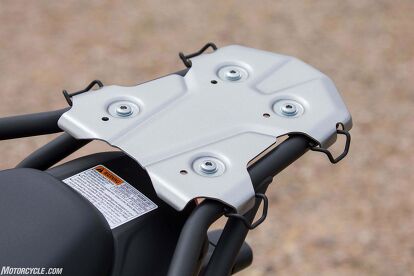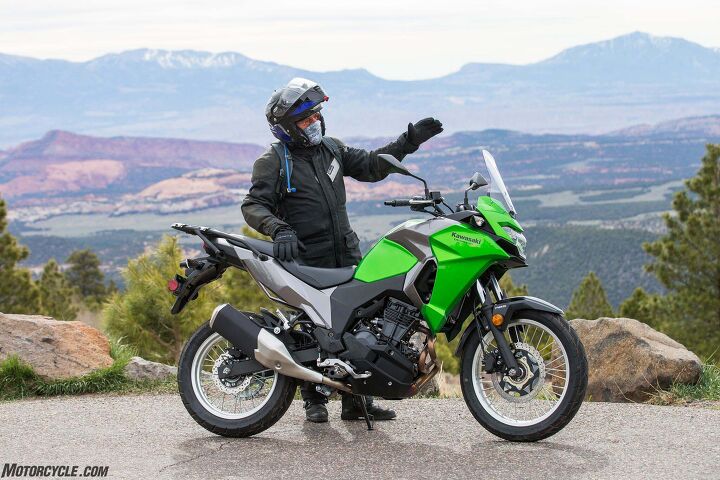2017 Kawasaki Versys-X 300 ABS Review
The littlest Versys might be the one to propagate your bigger adventures
I know at least two people who are convinced the Kawasaki Versys 650 is the world’s greatest do-it-all motorcycle, including our own Sean Alexander. I would not attempt to convince them otherwise. The big Versys 1000 is pretty swell, too, and now Kawasaki completes the circle with this all-new Versys-X 300, packing a revised version of the excellent 296cc Ninja 300 parallel-Twin.
2017 Kawasaki Versys-X 300
| Engine | 17.0/20 |
| Suspension/Handling | 13.0/15 |
| Transmission/Clutch | 9.0/10 |
| Brakes | 8.0/10 |
| Instruments/Controls | 4.0/5 |
| Ergonomics/Comfort | 8.5/10 |
| Appearance/Quality | 9.0/10 |
| Desirability | 8.5/10 |
| Value | 9.0/10 |
| Overall Score | 86/100 |
2017 Kawasaki Versys-X 300 Preview
In Versys tune, not much has changed except EFI tuning, longer intake funnels inside a new airbox and longer exhaust headers, all of which contribute to stronger low- and mid-range power. We’ve still got 10.6:1 compression and twin 32mm intake tracts. The Versys makes surprisingly decent power as low as 4000 rpm, and it’s all done by 11,000 – pretty much just like the little Ninja, which won our 2015 Beginner-ish Sportbike Shootout, cranking out 34.6 horsepower at 10,800 rpm in the process (and 17.6 lb-ft torque at 9700).
That’s not a lot of power, but it usually feels like enough in the Versys because of its impressive weight figure: just 386 pounds, says Kawasaki, and that’s with 4.5 gallons of gas. That claim should be accurate, too, since our scales were within three pounds of Kawasaki’s claim for the Ninja 300, which weighs 381 lb. That’s 266 pounds less than the Ducati Multistrada Enduro we tested last year, the Versys’ seat is 2.1 inches lower than that bike, and the Versys ABS model sells for $5,699 to the Ducati’s $21,295 ($24,841 as tested). This one’s for the minimalist adventure biker, more suited for blatting around Walden Pond than for blasting around the Sahara. But that really depends on the adventurer. If I dropped a 647-pound bike alone on the veldt, it’s vulture time. When the Versys’ kickstand punched through a thin crust of dirt above a sea of talcum powder at a stop and fell over, I picked it right back up.
You sort of need to be a tall expert off-roader to use all the Multistrada has to offer, but just about anybody can sidle up to the Versys. Product Manager Croft Long says the little Versys fills a gap in the market, a previously non-existent category for a small-displacement street adventure bike that can be adopted for touring. It’s a bandwagon Kawasaki isn’t going to be on by itself for long, though, since there’s a new Honda CRF250L Rally and a new BMW G310GS on the way. We also expected the new Suzuki V-Strom 250 to be arriving soon, but Suzuki now tells us that it’s currently not scheduled to be included in the lineup on our shores.
Getting here first has to count for something, and so it was off to Utah to grab first riding impressions of the new Kawasaki. For those worried about size (all of us), the Versys doesn’t look like a shrunk-down scale model of a real adventure bike at all. Kawasaki wanted it to at least look like a real-live ADV bike, and so there’s quite a bit of airspace behind the bodywork up front, which was a nice place to tuck away things like coolant overflow tanks and charcoal canisters, leaving the exterior clean and uncluttered.
A 32.1-inch seat height is just about right for 5-foot-8 yours truly and my 30-inch legs, and still high enough off the ground to let the suspension stroke through 5.1 inches up front and 5.8 at the rear. Ergos for me are completely transparent and upright comfortable. The pull on the slip-assist clutch is possibly an all-time record for lightness, and away we go. The seat feels unusually firm, though, stiff foam with a masonry base, feels like.
Just like the baby Ninja, it’s all about the rpm, and just like it, the Versys is exceedingly generous with them. You’re turning 8000 rpm in sixth gear to generate 66 mph, which was a sweet spot on my test Versys, and dialing up 80 mph and 9600 rpm had it feeling almost as happy. Getting up to that speed takes a little patience. Even if it weighs close to the Ninja, the Versys presents a lot more frontal area. You’ll be flogging it to redline a lot to get real acceleration, not that that’s a bad thing. The engine’s bolted into the new steel backbone frame solidly, but its internal counterbalancer keeps vibration to an extremely low level across the rpm range – not that there’s not a very, very light tingle most of the time that bothers me not at all.
That “large-volume bodywork” out front does a good job poking a hole in the chilly Utah air heading west out of Green River, and the unadjustable windscreen would be better for me if it were about an inch taller. Hunkering more than usual got me into smooth airflow. Say, where’s the heated grip button? There isn’t one, and not as an option either. There is an optional 12V outlet with a spot already picked out for it on the dashboard, but Kawasaki says it’s really only for charging your phone. Even an electric vest might draw too much juice. Nobody claimed to know how many watts the little Versys puts out, but it seems like not many. Oh wait, here it is now in my inbox: 35 volts at 4000 rpm. A more recent emails says the tri-phase alternator kicks out 21.0 amps at 5000 rpm.
But hey, a smaller alternator, two brake discs instead of three (two are plenty) – these are all places where we save weight and money, both of which numbers are the Versys biggest selling points. The 386 pounds we already mentioned; the $5,699 for the ABS version also seems cheap enough, and the non-ABS bike is $300 less than that. So why would you even consider the non-ABS version? Because you can’t switch it off in the dirt. When you grab a hand- and footful of brakes on the ABS bike on a downhill section of shaley dirt road, you keep right on going. On pavement too, ABS seems to kick in a smidge before you’ve reached maximum retardation. Having picked that nit, the Versys again uses its light weight to stop plenty hard on pavement with its 290mm and 220mm front and rear discs. Surely there’s a way to wire in a switch to disable ABS when you’re off road? Why didn’t Kawasaki do it? We’re back to $5,699.
Heavy braking is also abetted by the fact that the suspension is surprisingly firm; the 41mm fork doesn’t freak when you slam the brakes on, the little bike handles graded dirt-road chop with ease, and it even seems like it wouldn’t have too hard of a time at all nipping at the heels of Sister Ninja on curvy pavement. With my 170 pounds on board, the little bike responds to firm handlebar inputs right now and with no complaints, zero wallowing or any misbehavior. Overall on both pavement and dirt, the whole package feels very structurally sound and flex- and rattle-free. Then again, my bike only had 200 miles on it when we started out… In general, though, I think it’s safe to generalize that Kawasakis tend to be super-rugged machines.
For us being in the Utah outback, we actually didn’t spend much time at all “off road,” which I suspect is because all our bikes were ABS equipped. And I wouldn’t be surprised to learn our hosts were unaware of the fact that said ABS is unswitch-offable until after the route had been planned weeks before the crates arrived at Kawasaki HQ. Being unable to disable ABS is a liability when, say, riding a loose, shaley downhill section with a thousand-foot cliff on the outside.
Extrapolating, however, from the 19- / 17-inch wire-spoked wheel sizes, the firm suspension, the strong steel frame with reinforced shock mounting, the really light weight, yada, yada, I think this little Versys would make a fantabulous off-road explorer, especially with some slightly knobbier tires.
And with the 32.1-in seat height, I feel safe in further theorizing that I would’ve had no problem clearing the Big Bear off-road section on this bike upright, which resulted in quite a few expensively scuffed-up and oilpan-holed larger, taller, more advanced and way heavier motorcycles on last year’s Wire-Wheel Adventure shootout.
I mean, more power to all the wing-footed dirt gods who are capable of roosting those powerful beasts up and over the burning sands, and who have the disposable income and time to set off from John o’Groats to Patagonia. For the rest of us who are lucky if we can find a day or three every couple of months to indulge our wanderlust, and who’ve ridden past the same dirt roads dozens of times curious as to where they might lead, it’s hard to argue with this new little Versys for less than $6k. Especially since you know, as you set off down that mystery dirt road, that you’ll be able to extricate yourself if it turns into more than you bargained for; the simple fact you know you can pick your bike back up without assist by itself increases my personal adventurousness by about 1000%.
For now, the Versys 300’s nearest competitor might be the Honda CB500X, which weighs about 40 pounds more, makes a bit more power from its 471cc Twin, but costs at least $1k more. Honda’s CRF250L Rally, which will be reviewed on MO this week, specs out on Honda’s site as being a whopping 70 pounds lighter than the Versys, but then it’s a Single, not a genuine Ninja! Twin. Sounds like the new BMW G310 GS isn’t going to show up until this Fall. And no V-Strom 250 for U.S. market.
There it is, then: For now, the Versys-X 300 is a party of one, and it’s a really lively one. Little bikes like this are tons of fun, and affordable for just about anyone. All of you who keep asking where all the fun little basic motorcycles have gone are looking right at a superb one.
2017 Kawasaki Versys-X 300 ABS
+ Highs
- Light weight, low seat, low price
- Super comfy ergos for a wide range of riders
- Sporty suspension, great structural integrity
– Sighs
- More juice to run heated grips and things would be nice
- Hard seat foam encourages standing on the pegs a lot
- You really should be able to turn off the ABS off-road
2017 Kawasaki Versys-X 300 Specifications | |
|---|---|
| MSRP | $5,399 base; $5,699 with ABS |
| Engine Type | Liquid-cooled, 8 valve, DOHC parallel Twin |
| Displacement | 296cc |
| Bore/Stroke | 62 x 49 mm |
| Compression Ratio | 10.6:1 |
| Maximum Power (claimed) | NA |
| Maximum Torque | NA |
| Fuel system | Direct fuel injection, two 32mm throttle bodies |
| Exhaust | Stainless two-into-one |
| Final drive | O-ring chain |
| Clutch | Wet, multi-plate slip assist |
| Gearbox | 6-speed |
| Frame | Steel backbone |
| Swingarm | Twin-sided, steel |
| Front Tire | 100/90-19 |
| Rear Tire | 130/80-17 |
| Front Suspension | Showa 41mm fork, 5.1 inches travel (130mm); no adjustments |
| Rear Suspension | Single shock, Uni-Trak linkage, 5.8 in travel (147mm); adjustable for spring preload |
| Front Brake | Single 290mm petal disc; ABS optional |
| Rear Brake | Single 260mm petal disc; ABS optional |
| Instrument Display/Functions | Analog tachometer, multi-function display with digital speedometer, gear position indicator, fuel range, current and average fuel consumption, Economical Riding Indicator(KP), coolant temperature |
| Seat Height | 32.1 in (750mm) |
| Wheelbase | 56.7 in (1439mm) |
| Rake | 25.1º |
| Trail | 4.0 in (102.4mm) |
| Curb weight (claimed) | 385.9 lbs |
| Fuel Tank Capacity | 4.5 gallons |
| Colors | Green, Grey |
| Warranty | 12 month limited warranty |
More by John Burns































































Comments
Join the conversation
I'll stick with my DR650, 324 lbs dry and a much lower rpm power band.
I'm wondering if this is like a lighter KLR650 for the 21st century.